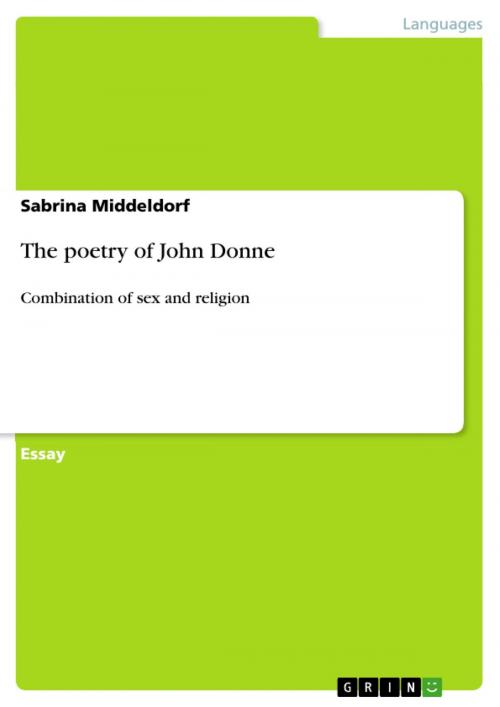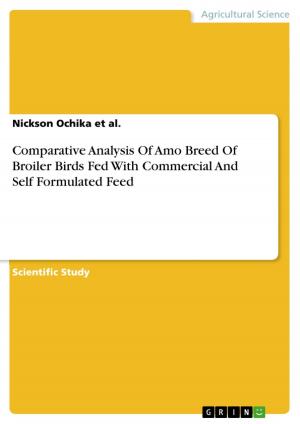The poetry of John Donne
Combination of sex and religion
Fiction & Literature, Literary Theory & Criticism, British| Author: | Sabrina Middeldorf | ISBN: | 9783640614714 |
| Publisher: | GRIN Publishing | Publication: | May 6, 2010 |
| Imprint: | GRIN Publishing | Language: | English |
| Author: | Sabrina Middeldorf |
| ISBN: | 9783640614714 |
| Publisher: | GRIN Publishing |
| Publication: | May 6, 2010 |
| Imprint: | GRIN Publishing |
| Language: | English |
Essay from the year 2008 in the subject English - Literature, Works, grade: 2,0, National University of Ireland, Maynooth (English Department), course: Renaissance and Restoration, language: English, abstract: Introduction John Donne was born in 1572 to catholic parents, converted to Anglicanism, married Anne More secretly and became Dean of St. Pauls at the age of 39. He is known as an erotically charged religious poet, whose sacred and profane poems seem equally passionate but he is also famous for his metaphysical poems. Metaphysical poetry typically had a special conceit, a metaphor like Donne's metaphor of the compass and unites two usually opposing motives like sex and religion. This brief introduction into the life of John Donne shows that he has a certain obsession towards both, religion and sex: as a man of the church he converted to Anglicanism and became Dean of St. Pauls, but as a lover of a woman he secretly married his beloved wife. Keeping these facts in mind I will exemplarily analyse two of Donne's poems, namely The Flea and Elegy XX - To his Mistress going to bed to find out, whether sex and religion really are modifications of the same energy in Donne's metaphysical poems. The Flea The poem consists of 3 stanzas with 9 lines each and the meter alternates between iambic tetrameter and iambic pentameter. The rhyme scheme is a rhyming couplet following the pattern AABBCCDDD, the final line rhymes with the final couplet. The first hint on a common origin of sex and religion is the form of the poem. It has three stanzas but the rhyme scheme is a rhyming couplet (apart from the last line): three as an uneven number is a divine number representing the Trinity whereas two as an even number is a worldly number mirroring all profane, like Adam and Eve representing mankind. Nevertheless these modifications of the form derive from the same origin, the poem as a whole. The three stanzas of the poem tell of a man and a woman that are both bitten by a flea. In the first stanza the flea bites the speaker first and is about to bite the woman. By doing this the flea unites their bloods in its body. In Renaissance times exchanging fluids was thought to happen when two people
Essay from the year 2008 in the subject English - Literature, Works, grade: 2,0, National University of Ireland, Maynooth (English Department), course: Renaissance and Restoration, language: English, abstract: Introduction John Donne was born in 1572 to catholic parents, converted to Anglicanism, married Anne More secretly and became Dean of St. Pauls at the age of 39. He is known as an erotically charged religious poet, whose sacred and profane poems seem equally passionate but he is also famous for his metaphysical poems. Metaphysical poetry typically had a special conceit, a metaphor like Donne's metaphor of the compass and unites two usually opposing motives like sex and religion. This brief introduction into the life of John Donne shows that he has a certain obsession towards both, religion and sex: as a man of the church he converted to Anglicanism and became Dean of St. Pauls, but as a lover of a woman he secretly married his beloved wife. Keeping these facts in mind I will exemplarily analyse two of Donne's poems, namely The Flea and Elegy XX - To his Mistress going to bed to find out, whether sex and religion really are modifications of the same energy in Donne's metaphysical poems. The Flea The poem consists of 3 stanzas with 9 lines each and the meter alternates between iambic tetrameter and iambic pentameter. The rhyme scheme is a rhyming couplet following the pattern AABBCCDDD, the final line rhymes with the final couplet. The first hint on a common origin of sex and religion is the form of the poem. It has three stanzas but the rhyme scheme is a rhyming couplet (apart from the last line): three as an uneven number is a divine number representing the Trinity whereas two as an even number is a worldly number mirroring all profane, like Adam and Eve representing mankind. Nevertheless these modifications of the form derive from the same origin, the poem as a whole. The three stanzas of the poem tell of a man and a woman that are both bitten by a flea. In the first stanza the flea bites the speaker first and is about to bite the woman. By doing this the flea unites their bloods in its body. In Renaissance times exchanging fluids was thought to happen when two people















